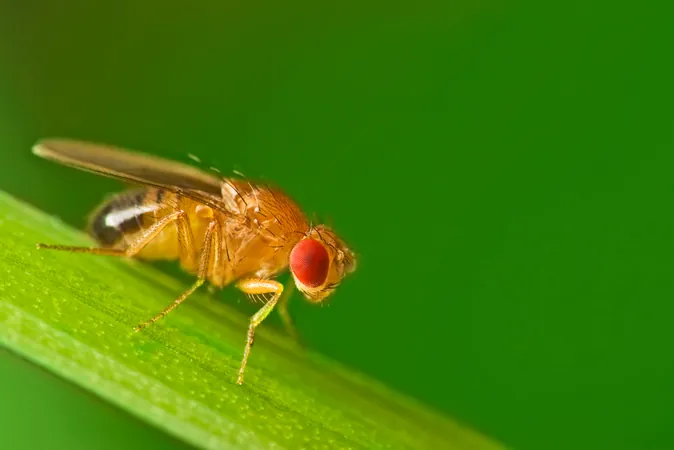
Unlocking the Secrets of Genetic Resilience: How Fruit Flies Beat Environmental Change
2025-09-15
Author: Rajesh
A Breakthrough Study at Stanford University
In a groundbreaking study, researchers at Stanford University have uncovered how fruit fly populations can thrive amid rapidly changing environments, a survival skill crucial for facing future challenges. This exploration delves into the heart of genetic diversity and its vital role in resilience.
Introducing Dominance Reversal in Genetics
The findings unveil a remarkable phenomenon known as "dominance reversal." This concept illustrates how certain genetic variants switch between dominant and recessive roles, depending on environmental conditions, effectively bestowing these flies with long-term resistance to pesticides.
The Challenge of Survival in Evolving Habitats
As habitats morph due to droughts, food scarcity, and human encroachment, a pressing question emerges: How do populations maintain the genetic diversity necessary for survival in the face of natural selection, which typically weeds out unhelpful traits over time?
The Stanford team tackled this riddle by tracking fruit fly evolution in an outdoor orchard setup where pesticide use was meticulously controlled. Their research, published in *Nature Ecology and Evolution*, is the first to provide direct evidence supporting the dominance reversal theory.
Adaptive Strategies: Dominance vs. Recessiveness
Traditionally, genetic variants (alleles) are categorized as dominant or recessive; dominant alleles dictate traits, while recessive alleles only manifest when the dominant counterpart is absent. In contrast, dominance reversal allows a single genetic variant to behave as dominant when advantageous—like developing pesticide resistance—and as recessive when detrimental, reducing survival in pesticide-free environments.
Senior author Dmitri Petrov explained, "Imagine not using pesticides for two decades. Once reintroduced, the flies quickly adapt and resist them. It’s as if they have a latent shield that activates only when danger arrives."
A Mechanism for Future Challenges?
The researchers assert that this adaptive mechanism might be widespread across various species, helping maintain genetic diversity in response to shifting environmental pressures. Lead author Marianthi Karageorgi adds, "Synthetic insecticides often mimic natural chemical defenses. This mechanism could have existed in nature for eons, enabling insects to maintain their resistance against variable chemical threats."
Experimental Evolution Unfolds in an Orchard
The concept of dominance reversal has been around since the 1950s, but this study marks the first real-life application of the theory. Using a blend of field and lab experiments alongside genetic surveys from diverse environments, the researchers were able to confirm that pesticide resistance is maintained at intermediate frequencies over time.
An outdoor orchard served as their experimental playground, where the flies evolved under natural conditions. As pesticides were introduced mimicking seasonal applications, not only did resistance flourish in treated populations, but even untreated flies maintained their genetic variants over time, raising intriguing questions about resistance dynamics.
The Ripple Effect of Genetic Change
Further investigations revealed that changes in allele frequencies during pesticide application affected not just resistant loci but also impacted neighboring genetic regions. Petrov likened it to an earthquake—"When we apply pesticides, changes resonate throughout the chromosomes, increasing and decreasing frequencies in a wave-like effect."
The Bigger Picture: Evolving in a Changing World
This study not only sheds light on the mechanisms of genetic variation but also calls into question how strong selective pressures may dictate levels of genomic diversity in the wild. Petrov states, "Understanding these forces is crucial, and our quest continues: How do we extract knowledge from the complexities of nature?"
As this research unfolds, it promises to reshape our understanding of evolution, genetic resilience, and the intricate dance of survival in ever-changing environments.

 Brasil (PT)
Brasil (PT)
 Canada (EN)
Canada (EN)
 Chile (ES)
Chile (ES)
 Česko (CS)
Česko (CS)
 대한민국 (KO)
대한민국 (KO)
 España (ES)
España (ES)
 France (FR)
France (FR)
 Hong Kong (EN)
Hong Kong (EN)
 Italia (IT)
Italia (IT)
 日本 (JA)
日本 (JA)
 Magyarország (HU)
Magyarország (HU)
 Norge (NO)
Norge (NO)
 Polska (PL)
Polska (PL)
 Schweiz (DE)
Schweiz (DE)
 Singapore (EN)
Singapore (EN)
 Sverige (SV)
Sverige (SV)
 Suomi (FI)
Suomi (FI)
 Türkiye (TR)
Türkiye (TR)
 الإمارات العربية المتحدة (AR)
الإمارات العربية المتحدة (AR)